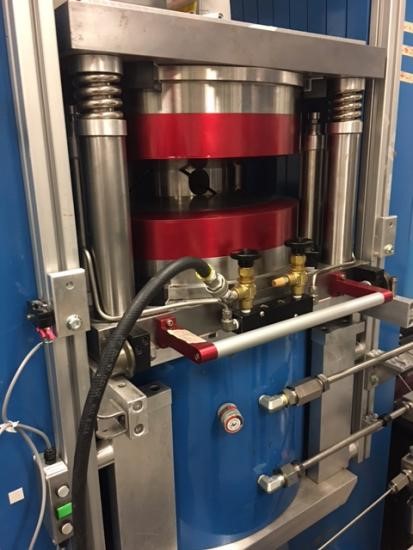Skip Navigation
Search
MAXPD
 |
 |
The Multi-Anvil X-ray facility at the XPD-D (28-ID-2-D) Beamline of the National Synchrotron
Light Source II (NSLS-II) is a new cutting-edge facility designed to push the limits
of high pressure multi-anvil synchrotron research. The MAXPD (Multi-Anvil X-ray Powder
Diffraction) facility is one of the spiritual successors to the X17MAC facility at
NSLS-I, which ceased operations in late 2014. This program was best known for the
development of high pressure and high temperature experimental deformation/rheological
techniques and in situ ultrasonic interferometry experiments at extreme conditions.
This legacy continues here with the further development of these and other experimental
techniques to expand the range of possibilities in high pressure studies.
The MAXPD facility is located in the downstream D hutch on the XPD beamline, which is served by a 1.8T damping wiggler insertion device. The facility contains an 1100-ton hydraulic press with DIA, Deformation-DIA, T-25 (Kawai-style multi-anvil), and the first ever functional Deformation-T-25 compressional modules. MAXPD utilizes monochromatic X-Ray beam (usually 52 keV or 67 keV). The experimental setup makes use of a Point Gray Grasshopper 3 CCD camera focused on a YAG scintillator crystal to allow for imaging of the sample during experiments, and a Perkin-Elmer area detector for collection of angle-dispersive X-ray diffraction spectra. The MAXPD facility is in the process of developing an on-site fully equipped sample and experiment preparation laboratory that is maintained by beamline staff, as well as preparation facilities at Stony Brook University that are maintained and operated by the Mineral Physics Institute. These preparation facilities are/will be available to facility users. This facility has been open to General Users since the 2018-1 beam cycle.
Our Strategic Plan
1. Provide and maintain a state-of-the-art community facility for high pressure research in mineral physics and materials sciences.
2. Continue to develop new techniques and enhance existing techniques focusing on the unique strengths this beamline provides to the users of the Multi-Anvil community.
3. Play an active role in the development of a world-class high pressure program that will take advantage of the unique features this new facility at XPD can provide.
Major Techniques: High Pressure, High Temperature Experiments in Multi-Anvil Apparatus; Angle Dispersive X-Ray Diffraction; X-Radiographic Imaging; Non-Hydrostatic Deformation Experiments using Differential Hydraulic Rams; Ultrasonic Interferometry Measurements of Elasticity and Acoustic Wave Velocities
Types of Studies: P-V-T Equation of State, Phase Transformations, Phase and Melting Relationships, Rheological Properties, Transport Properties, Texturing, Yield and Shear Strength Analysis, Thermoelastic Properties, Compressibility, Structural Analysis and Refinement, Elasticity and Acoustic Velocity Measurement, and other Physical Properties and their Time Dependences
Types of Materials Studied: Minerals, Metals, Glasses, Melts, Oxides, Silicates, Ceramics, Energy Materials, Hard and Superhard Materials, Single Crystals, Polycrystals, and much, much more!
The MAXPD facility is located in the downstream D hutch on the XPD beamline, which is served by a 1.8T damping wiggler insertion device. The facility contains an 1100-ton hydraulic press with DIA, Deformation-DIA, T-25 (Kawai-style multi-anvil), and the first ever functional Deformation-T-25 compressional modules. MAXPD utilizes monochromatic X-Ray beam (usually 52 keV or 67 keV). The experimental setup makes use of a Point Gray Grasshopper 3 CCD camera focused on a YAG scintillator crystal to allow for imaging of the sample during experiments, and a Perkin-Elmer area detector for collection of angle-dispersive X-ray diffraction spectra. The MAXPD facility is in the process of developing an on-site fully equipped sample and experiment preparation laboratory that is maintained by beamline staff, as well as preparation facilities at Stony Brook University that are maintained and operated by the Mineral Physics Institute. These preparation facilities are/will be available to facility users. This facility has been open to General Users since the 2018-1 beam cycle.
Our Strategic Plan
1. Provide and maintain a state-of-the-art community facility for high pressure research in mineral physics and materials sciences.
2. Continue to develop new techniques and enhance existing techniques focusing on the unique strengths this beamline provides to the users of the Multi-Anvil community.
3. Play an active role in the development of a world-class high pressure program that will take advantage of the unique features this new facility at XPD can provide.
Major Techniques: High Pressure, High Temperature Experiments in Multi-Anvil Apparatus; Angle Dispersive X-Ray Diffraction; X-Radiographic Imaging; Non-Hydrostatic Deformation Experiments using Differential Hydraulic Rams; Ultrasonic Interferometry Measurements of Elasticity and Acoustic Wave Velocities
Types of Studies: P-V-T Equation of State, Phase Transformations, Phase and Melting Relationships, Rheological Properties, Transport Properties, Texturing, Yield and Shear Strength Analysis, Thermoelastic Properties, Compressibility, Structural Analysis and Refinement, Elasticity and Acoustic Velocity Measurement, and other Physical Properties and their Time Dependences
Types of Materials Studied: Minerals, Metals, Glasses, Melts, Oxides, Silicates, Ceramics, Energy Materials, Hard and Superhard Materials, Single Crystals, Polycrystals, and much, much more!
